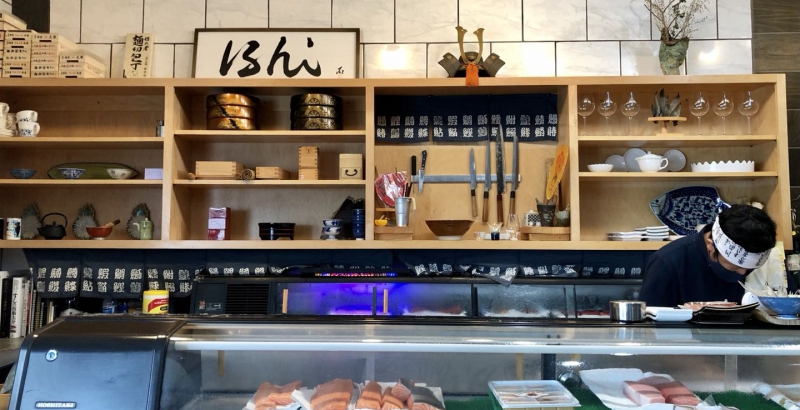The Japanese restaurant ISHI Sushi & Kaori’s Oven is owned by the lovely couple Ken and Kaori Ishibashi. This little family-owned Japanese corner-store style restaurant gives that warmth to customers by offering Japanese cuisine and baked goods made from fresh ingredients. What’s the story about how they opened a unique restaurant, one different from restaurants offering Asian-fusion cuisine? What’s the thought behind having a bakery as part of the restaurant? What does the preparation for the omakase look like?
The restaurant has been open for almost half a year. Along the way, the owners have made better adjustments to serve customers and improved the menu to introduce more. What should customers expect to see on the menu in 2022?
I stopped by ISHI & Kaori’s Oven to chat with Ken and Kaori Ishibashi about their recent venture of this cute Japanese family-style restaurant.
I first interviewed Kaori about her experience opening her own Japanese-style bakery.
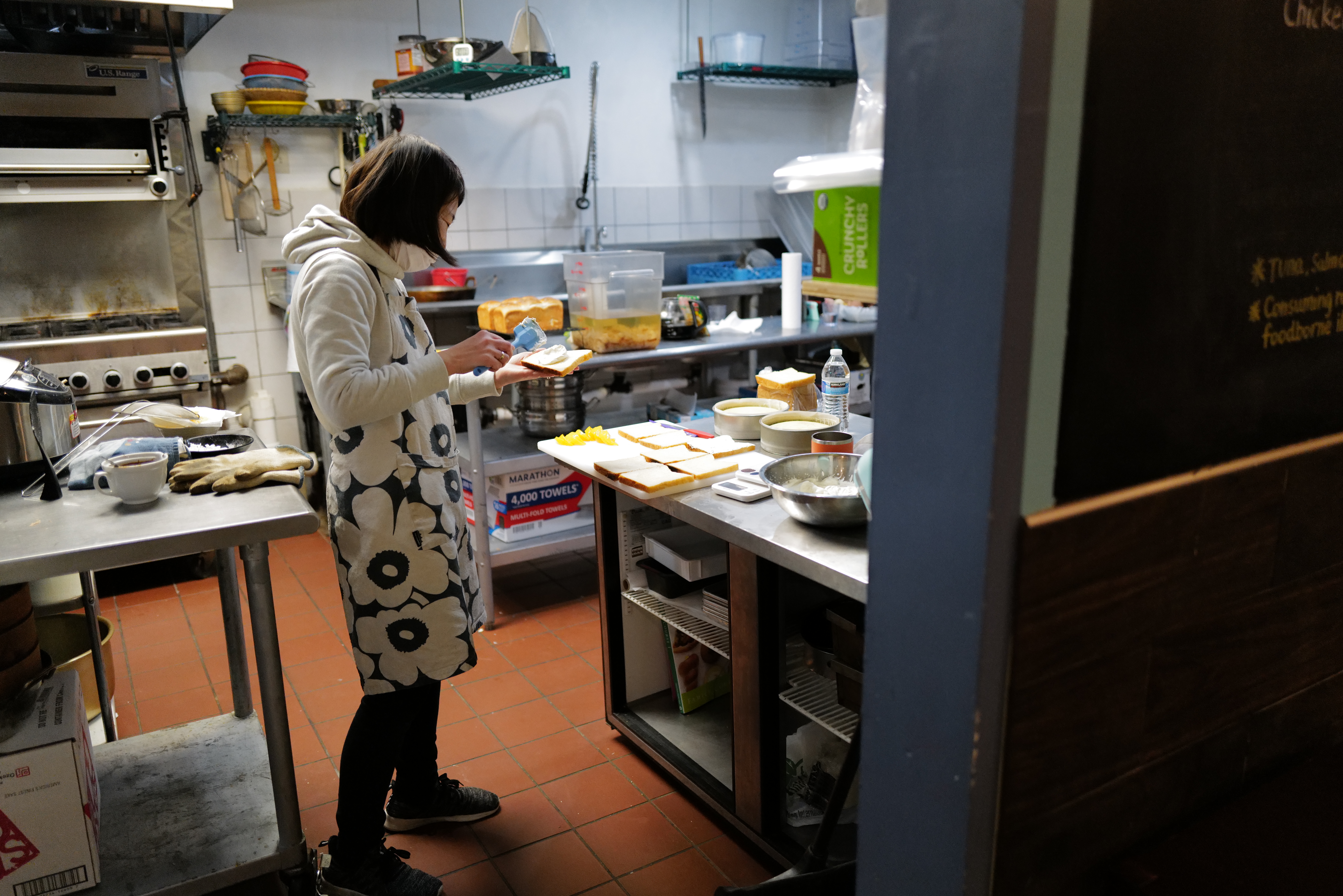
Photo by Ken Ishibashi.
Smile Politely: Can you talk about your experience with pastry making? How did you get into it?
Kaori Ishibashi: Before I moved to the U.S., my husband told me that there was no good bakery in town, but in my hometown, there are so many good bakeries. Every corner has maybe two bakeries, like every three steps, you can find a bakery. In Japan, it’s very popular that my town has the most bakeries. Growing up there, I always ate bread, and my mom really likes bread, too.
When my husband told me this, like, oh, no good bakery! I thought, what should I do? I can’t survive without bread. I started to make bread by myself.
SP: What did you do before you were a pastry chef at Kaori’s Oven?
Kaori: After coming here, I taught bread baking to Japanese people who live here. And then we [Ken and I] always wanted to have our own place. But at first, my husband was working in a restaurant. After that, he decided to open our own restaurant serving sushi and bread. Sounds weird, but let’s try! When we opened it, people buy bread and come for sushi — and it works.
SP: What is a typical day like? How does the prepping of pastry work?
Kaori: Kaori’s Oven currently opens every Tuesday, Wednesday, and Thursday from 9 a.m. to 11 a.m. I prepare the filling for the pastries a day before. Some dough I made it a day before, and some I made in the morning before the Oven opens. I try to come here at 6 a.m. to prepare. Customers usually come at around 9 a.m., but most people come at 10 a.m.
SP: What’s most popular items on the bakery menu? What’s your personal favorite among them?
Kaori: Right now, the most popular is the animal bread. Many people come for the animal bread, so I always try to make more. Personally, I like the savory one with bacon shiso cream cheese the most.

Photo by Kaori Ishibashi.
SP: What are your favorite Japanese dishes?
Kaori: Do you know omurice? The egg over rice. The first of our dates — me and my husband, we went for omurice. That was really good.
SP: Do you take custom orders for pastries? If so, what do people order?
Kaori: Usually people order cake, like whole cheesecake and matcha cake because I usually sell slices only. Some people put order of loaf bread, too.
SP: What should customers expect from the bakery in 2022 for the menu and Kaori’s Oven?
Kaori: We’re trying to open longer for the lunch; then we can do more Japanese food like omurice and hamburg steak with rice. The Japanese hamburg steak is unique because you put the loaf bread inside. We have many ideas about what we want to do. We want to do it little by little.
SP: What do you like to do when you’re not making pastries?
Kaori: Right now, I only play with kids when I’m not making pastries. We spend 12 hours in the restaurant every day.
SP: What restaurants do you like to eat at in town when not at ISHI?
Kaori: We used to go to Black Dog often. After COVID, we didn’t go to dine in. And we love to go to the Japanese supermarket Mitsuwa for shopping and eat food there.

Photo by Xiaohui Zhang.
Next, I chatted with Ken about his sushi experience and his story of opening a Japanese restaurant in town.
Smile Politely: First, can you introduce yourself and your experience before working as a sushi chef at ISHI?
Ken Ishibashi: Champaign is kind of my adopted hometown. I’m actually from Mattoon. I came here my early twenties. I worked at Kamakura restaurant, the only Japanese-run restaurant in Champaign. They did the teppanyaki and sushi.
I started as a dish washer there and moved up to sushi bar. I did that for like three years and had the opportunity to move to Japan to work. I just thought that was the best choice I had at that time, so I went. I came back in 2014, and I started to work at Kamakura again. I worked there twice, and they ended up closing. I went to a friend who was a bartender at Miga. He said he can get me a job there.
It was my first time to do a real line cook job, so I was really nervous and prepared a lot. After that, I went to Sakanaya, and after COVID, I got displaced. And then, I was actually making breakfast in Monticello. I went back to campus at a Thai restaurant. The lady had a sushi bar there, and we agreed to open a sushi bar there. That place ended up closing.
A friend of mine told me about this place — her friend’s father owns this place. I made the business plan, and they accepted it. I didn’t really intend to open a restaurant right away, but the opportunity was there, so we ran for it. For me, just the goal for this place is to be stable. Because it was very unstable after COVID; I was unemployed. It’s very difficult to be stable right now.
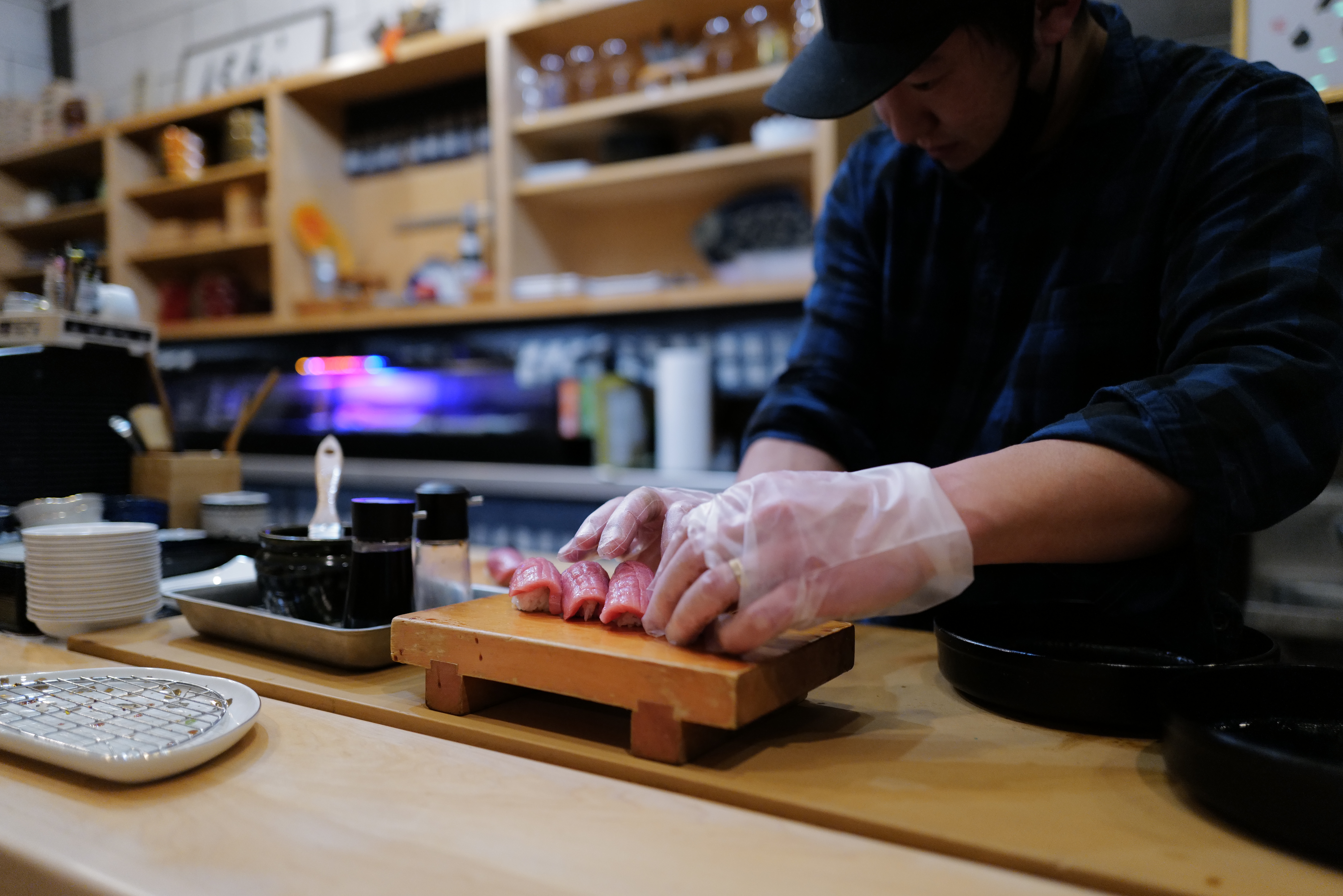
Photo by Kaori Ishibashi.
SP: What are important features in your mind for a good Japanese restaurant?
Ken: I just want to be as true to a sushi chef as much as possible. Restaurants have to cut some corners, certain corners just to survive. But when I went back to campus starting to work on whole fish, I would get the whole fish and start from there. I would have to break down the fish instead of having it already fileted or frozen in a packet. I really enjoyed that part because keeping fish fresh is difficult. It’s like a countdown once you get the fresh fish. To keep it fresh is really challenging — and also fun.
SP: When did you start to learn making sushi?
Ken: Sushi is very simple. You have the fish and rice. There is big importance of both. When I was young, I didn’t really think about it. Well, sushi is all about balance. It’s all about balance about the fish and the rice. I will taste the rice and fish individually and together.
SP: How do you come up with the idea to have omakase and Japanese pastries flowing in one place?
Ken: Initially, it wasn’t. We didn’t intend to do the omakase style. Initially I wanted to do bentos and some sushi. I also wanted to be in the kitchen as well. And when we first opened, we had a big reception from the community. At that point, the first couple of weeks was tough. So my wife said, “People want sushi. You have to make sushi.”
When I was working at other places, I had a lot of customers to take care of, and they would just order whatever is best. That’s how the omakase started where customers just leave it to me, and I just make them whatever is the best. I kind of feel the restaurant just formed organically into where I just do what’s most comfortable as far as making sushi stuff. We have limited staff. Fish is obviously limited as well. Doing a set menu is easier for me to get in a flow, whereas by-order is really tough.
When Kaori and I were living in Japan, we both took a big interest in food. She started to do baking classes for her friends. I started experience with food in Japan. We both have very strong passion in food. That’s our connection to each other. So yeah, we just didn’t have any expectation when we opened, but we just know we have to open it to survive. We just let it take its course and then adjust weekly.
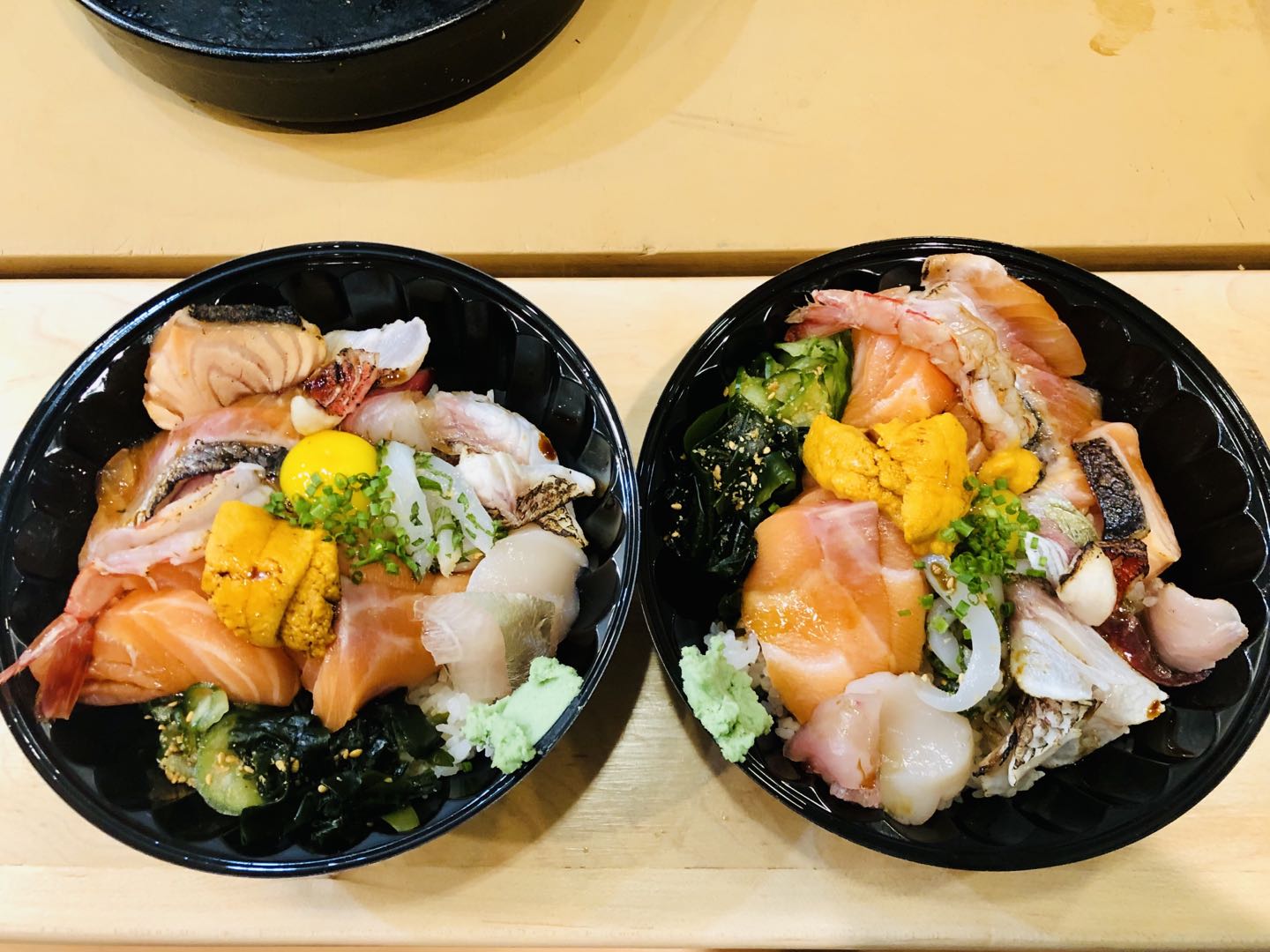
Photo by Xiaohui Zhang.
SP: Who’s the mind behind the omakase menu? How do you decide what to serve every week
Ken: For Japanese cuisine, there’s a kind of like a playbook, you know: soup, a bit of sashimi, hot dish, some sushi. That’s the plan for the omakase: just have nice soup, a little side dish, some sushi. My distributor, they actually get fish flown from Japan weekly. That fish list changes every week. It’s seasonal and different every week. So that’s when I choose maybe this fish, this fish, and try to get a balance between those selections. If people come often and weekly, I’ll try to serve them something different as last time.
SP: What’s a usual business day like?
Ken: We get the fish on Wednesday, and I try to have all the fish ready by Thursday. When I get the fish, some fish have the guts and scales and everything, so I make sure that is all finished by Thursday.
When I get here on Friday, one of the most important dishes is the soup. As I’m cleaning the fish, I’ll have a pot for the stock, so I have fish bones, head, and I’ll just throw into the stock to make a nice seafood stock for the miso soup. Once the fish is ready, I’ll put it into the sushi case. The most important thing is the rice. It’s kind of the last thing since it couldn’t be cold. Usually for the lunch seating, the rice was just made ten minutes ago. Still, with nice temperature.

Photo by Xiaohui Zhang.
SP: Can you name one of your favorite Japanese dish?
Ken: I have certain memories of food I’ve eaten in Japan. The most recent one is okonomiyaki. We were at the airport, and we were saying goodbye to Kaori’s parent. We ate okonomiyaki as our last meal at the airport. I still remember that okonomiyaki. and it was so good.
In Japan, the food is really original, so each region has their own specialty. For example, Osaka is famous for takoyaki. When I have friends come over, we would go to all the takoyaki shops, just like one after another. I guess my favorite dish is just a simple udon. Udon is very basic. My family comes from Shikoku, and they are famous for udon. The udon shops there, they hand-make the udon noodles and serve in Katsu broth. You can get it for $2.
SP: In additional to omakase and the listed menu items, do you also take customized orders? If so, what do people usually like to order?
Ken: Recently if people want to-go, it’s basically the omakase in a to-go form. Whatever I have in the case, that’s for the omakase. I’ll just make a small bento for them using all the ingredients that I have for that day. I try to make it look as nice as possible, putting some sashimi, nigiri, roll, and a little bit of salad.
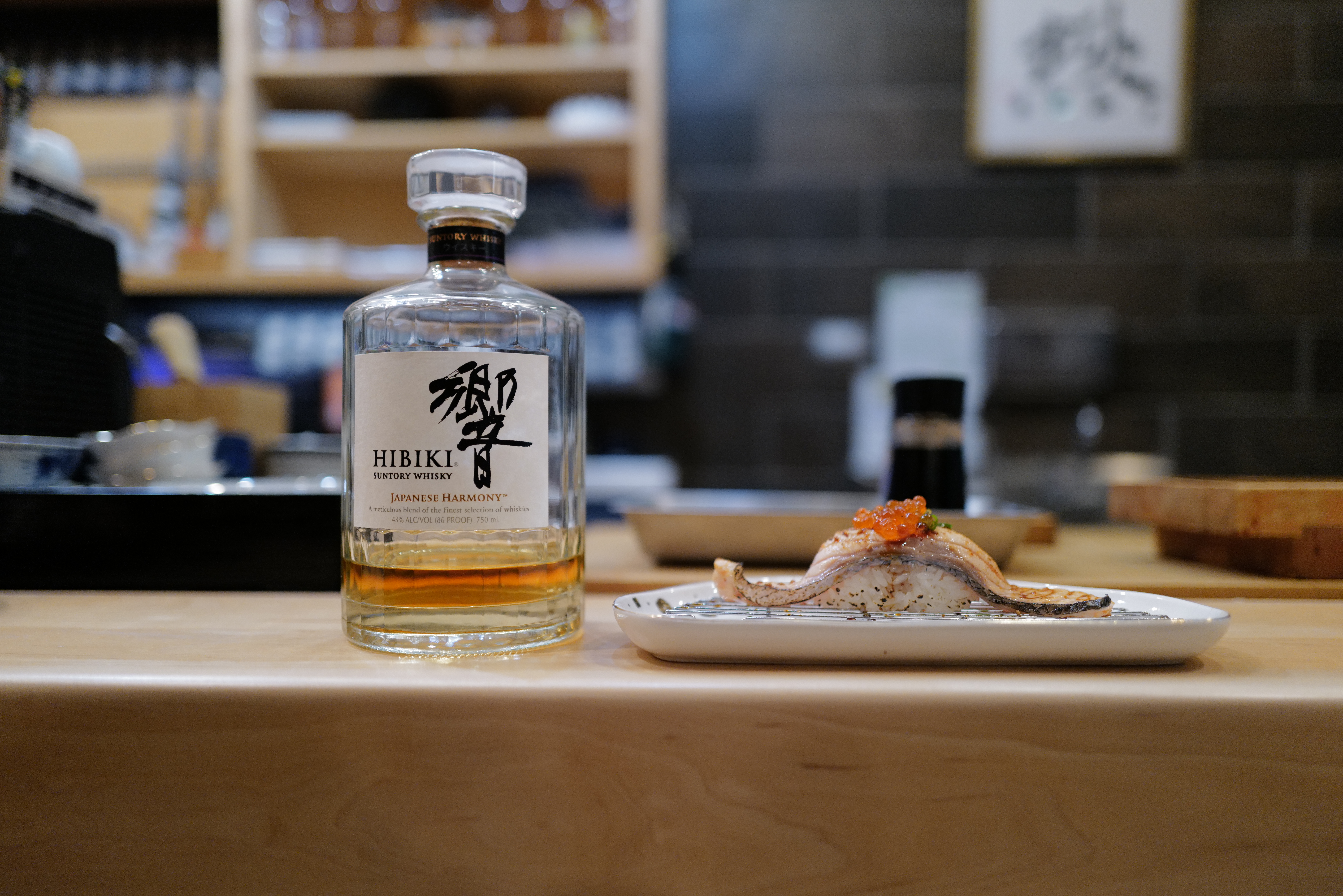
Photo by Kaori Ishibashi.
SP: Do you have new plan for the restaurant in 2022? What should our readers expect?
Ken: We’re not very active in technological world at the moment, and we’re working with a team on our website now. We want to change Kaori’s Oven during the week, and once we get to a good point, we would like to launch some easy to-go days.
After the bakery, maybe we can open the kitchen and have some kitchen dishes stuff like that. Possibly to-go sushi we would like to do. The omakase is kind of eventful and fun for people to come — which is really nice and something we don’t have in town. But if we can find a apprentice, we can definitely extend the hours in the future.
Making this place is kind of making our own “Japan” here for us and for the community. We want to keep that atmosphere intact, and we don’t have plans to expand right now. We just want to be a little local Japanese place. That’s our goal. It’s kind of reminding us of being in Japan, being able to have your own little family-run corner shop.
SP: To make reservation at ISHI Sushi, you may text message through 217-254-5653 or via Google Map Assistant. To make customized order at Kaori’s Oven, you may contact 217-800-2275.
ISHI & Kaori’s Oven
305 Cedar St
Champaign
ISHI Sushi
F+Sa reservation only
Su noon tot 2 p.m.
Kaori’s Oven
Tu-Th 9 a.m. to 11:30 a.m.








